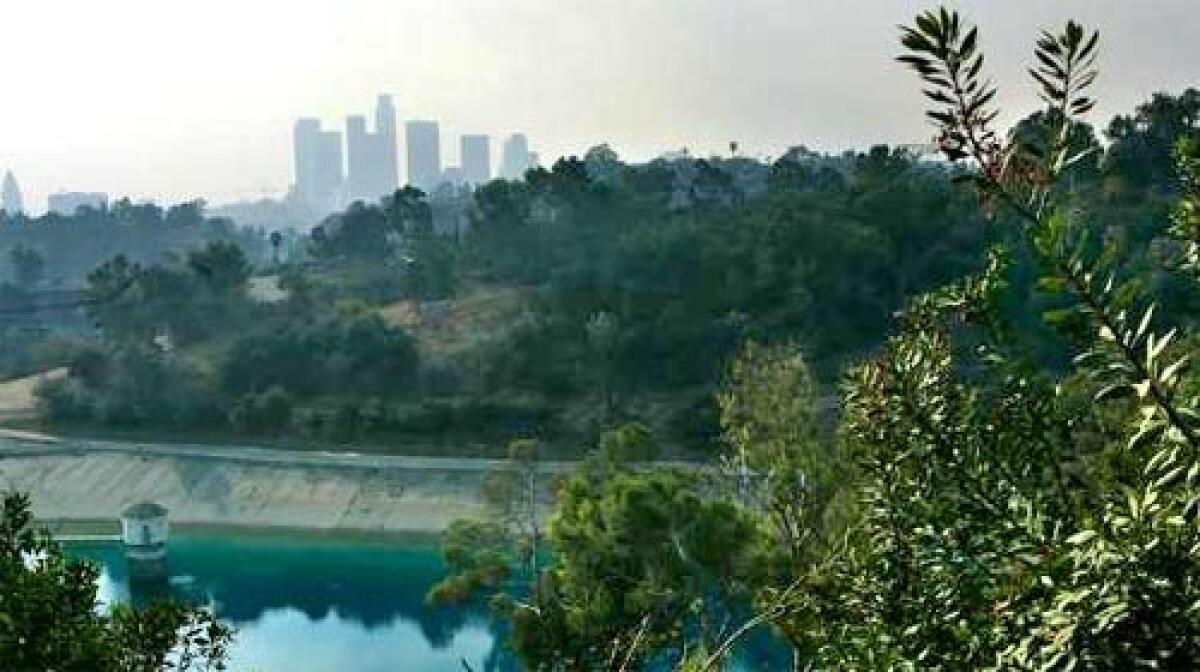L.A. must dump water from two reservoirs

In the midst of a drought, Los Angeles officials announced Friday that 600 million gallons of water must be dumped from two reservoirs that supply a swath of the city because an unexpected chemical reaction rendered it undrinkable.
Silver Lake and Elysian reservoirs registered elevated levels of the suspected carcinogen bromate between June and October, the result of an unusual combination of intense sunlight, bromide naturally present in groundwater and chlorine used to kill bacteria.
The reservoirs delivered water to an estimated 600,000 consumers, but state public health officials say the dangers were minimal. Bromate, they said, poses a small cancer risk only after being consumed daily over a lifetime.
Department of Water and Power officials said they removed the reservoirs from service within two days of learning about the problem in October and diverted wells that fed them. The reservoirs will be drained and cleaned early next year so they can be replenished for the high-demand summer season.
The state Department of Public Health commended the DWP’s action. But two elected leaders criticized the city agency for not alerting the public until Friday, more than two months after the contamination was discovered and only after being urged to do so by the state health agency.
“I praise the swift and quick reaction of the DWP, but I don’t like how long it took the residents of Silver Lake to find out about it,” said City Council President Eric Garcetti, who represents part of the area along with Councilman Tom LaBonge, who also criticized the delay. “The ratepayers deserve full information when public health is concerned.”
One of those ratepayers, Silver Lake resident George Hoyt, said he wasn’t happy to learn about the contamination from a reporter on Friday morning.
Hoyt, who makes a point of drinking tap water to save money, was dropping his 4-year-old son at the Neighborhood Nursery School, its swing sets sitting almost at the edge of Ivanhoe Reservoir, which abuts its larger Silver Lake cousin but was unaffected by the bromate.
The DWP said there was no risk to the children there or to others who frequent the fenced-off reservoirs. The perimeter of the Silver Lake site is a popular path for joggers.
“It seems to me that the whole point of having tap water is that it is supposed to be reliable drinking water,” Hoyt said.
DWP officials said they did not want to go public until they fully understood the cause of the problem, which affected water delivered to Elysian Park, areas south of Sunset Boulevard and east of Vermont Avenue, downtown and much of South Los Angeles.
State health officials said the DWP was not required to notify the public because the elevated bromate still fell below levels considered dangerous under state and federal clean water regulations.
To be in violation, bromate sampled each month must exceed 10 parts per billion on average over a year.
When DWP crews tested Silver Lake reservoir in October, the bromate level was 68 parts per billion; Elysian was 106.
The imminent water loss comes amid a prolonged dry spell that prompted Mayor Antonio Villaraigosa to call for voluntary conservation. But DWP officials downplayed the consequences, saying the two reservoirs account for less than 1% of the city’s annual water use.
And they say some of the water, while unsuitable for drinking, could be rechanneled for other uses.
Water from the Elysian Reservoir, for example, could be used to irrigate nearby hillsides, they said. And officials were trying to determine whether they could channel Silver Lake Reservoir, which contains the bulk of the supply at issue, to irrigate parts of Griffith Park or to fill Hollywood Reservoir as emergency reserves for non-drinking purposes.If not, it will simply be dumped into the Los Angeles River and carried to the ocean.
“At a time of water shortages, we are loath to [drain the reservoirs]. Every drop is precious,” said DWP General Manager H. David Nahai. “But we want to make sure that . . . the public continues to retain a high level of confidence in the quality of the water.”
Nahai said the agency became aware of the problem in October when an outside lab identified the existence of bromate; the lab traced the problem back to June.
The DWP conducted its own tests and immediately removed the two reservoirs from service, Nahai said. Officials said the bromate levels were a surprise because such a chemical reaction had never occurred in any of the city’s six reservoirs.
DWP officials said they also immediately tested all of the city reservoirs and determined that water was safe to drink at the remaining four.
DWP crews will begin draining the Silver Lake and Elysian reservoirs in January or February. New water could cost the DWP as much as $660,000.
In the meantime, customers normally served by the reservoirs will receive water pumped through the Ivanhoe Reservoir.
“The DWP is vigilant and will go to an over-abundance of caution in dealing with the water supply,” Nahai said. “The water supply is safe.”
More to Read
Sign up for Essential California
The most important California stories and recommendations in your inbox every morning.
You may occasionally receive promotional content from the Los Angeles Times.










